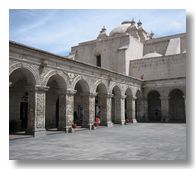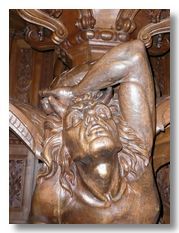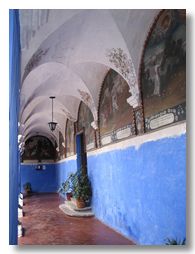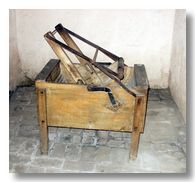The Peru Photos:-
Arequipa is surrounded by some beautiful snow-capped mountains & volcanoes. At a height of 2,350 metres above sea level (nearly 1.5 miles high), the city was our gentle introduction to living at high altitudes.
A lot of the city is constructed using sillar, a whitish volcanic stone. There is plenty of it about with so many volcanoes surrounding the city. These arches are made using sillar. There were lovely views over the city from this vantage spot.
This Jesuit church's decoration is particularly ornate in the Andean mestizo style (i.e. mix of Indian & Spanish art forms). Inside the main cloister (below) has been turned into a shopping precinct. Ann & I bought our Alpaca jumpers from here.

The Cathedral has a large frontage on to the Plaza de Armas. However on entering you realise that the facade is the side of the Cathedral, not the end of the nave. Apparently the depiction of the devil under this pulpit scared off many of the superstitious locals.

These specially imported Suzuki taxis are all over the centre of the city.
In the centre of Arequipa is the Santa Catalina convent dating from Colonial times. It housed a closed order of nuns, selected from the eldest daughters of the city's wealthy families. Over the years the number of nuns declined significantly. To help pay for the repairs following the 1960 earthquake, it was decided to open most of the Convent to the public in 1970. It is a fascinating glimpse into the nun's self-contained world. Many nuns had servants and lived in luxuriously appointed cells.
The convent is laid out like a small town, with alleyways named after places in Spain, e.g. Granada Street. At its height there were some 450 people in the convent - about half nuns and half servants. There are now only a couple of dozen nuns & no servants.

On the left is the outside laundry and below is an early washing machine.

A day's journey from Arequipa is the Colca canyon which is twice as deep as the Grand canyon in Arizona. It is a very wide valley without the sheer vertical sides of the Grand canyon, hence it is very deceptive to get a real feel for its depth. We started to get quite high here - over 2.5 miles up, with the air getting a bit thin. Luckily for me, my altitude sickness was just a slight headache - so not too bad. As with most of the Andes, the scenery here is stunning.
We stayed in Chivay in the Colca valley.
L to R; Jenny, me, Di, Sue, Ann, Michele, Jo, Harold, Gary & Alan.
Breathtaking to just sit and take in the views.
There was no waiting for the Condors. At the popular Mirador Del Condor there were several gliding by on the early morning thermal currents.
Condors are huge - the wingspan is over 3m. They hardly flap their wings, just using the thermal currents for lift. They are very curious birds and took a keen interest in us as they glided by - as if eyeing us up for a later lunch.
This shot & the one below give some idea of what the high Andes are like. It is a very rugged terrain.
The terracing dates back to pre-colonial days when every bit of land had to be cultivated.
